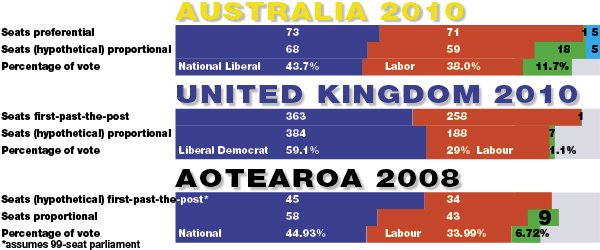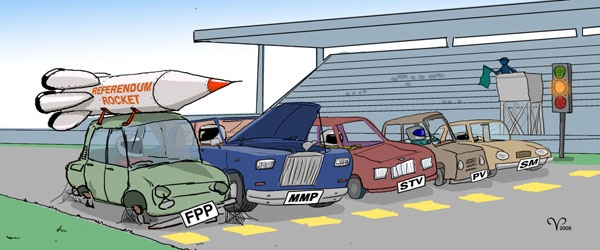Out of all proportional Aussies eat their Greens
Updated 9 September 2010

Greens Eaten: While New Zealanders risk losing the strict proportionality of their electoral system, Australian Green voters lament they have only one member in the House of Representatives, instead of the 18 or so they are due. chart Mahurangi Magazine
Grand coalition is the only honourable option. In yesterday’s election, neither major party obtained a mandate to lead Australia.
The undisputed winner, out of the shameful defrauding of Kevin Rudd and the Australian people, is the Green Party. Polling 11.7%, the Greens have won their first House of Representatives seat. Hypothetically, had this been a proportional election, the Green Party would now be sitting pretty with some 18 members in the federal parliament. This highlights the world of difference between Aotearoa and Australia’s respectively proportional and preferential systems.
With little more than half the Australian Green vote, the Green Party of Aotearoa polling 6.72% picked up nine list seats in 2008. Part of the reason it gained so many seats, is that Parliament currently contains a whopping 122 members, for fewer than three million enrolled voters. And while Australia has a total of 501 seats (including those of the 351 state politicians) for a little more than 14 million voters, this is still fewer that New Zealanders are deemed to need. The main reason for the difference, however, is that Aotearoa has a ‘proper’ proportional system—one where the proportion of seats won closely mirrors the percentage of party support. That is not to say Aotearoa’s implementation of mixed member proportional is perfect. The single most unpopular aspect is the size of the parliament. Ninety-nine members were thought to be too many, given their ritualised behaviour where half spent their days gratuitously denigrating the other half. The two-party charade was deeply despised, the sentiment being:
Once elected, they should be working together, for us.
By adding the list seats needed to achieve proportionality, to the existing 99, the 1986 royal commission added insult to injury. The result was the 1999 referendum, in which 81.5% voted to reduce back to 99 members. The referendum was non-binding and was ignored by Parliament.
Now, tragically, Aotearoa’s promising proportional system is poised to be dumped, rather than be tuned up. A dab of Australian preferential, in the right place, would readily address the system’s unpopular attributes. The attribute the 1986 royal commission was trying to preserve was the existing single-member electorates—folk like the accountability inherent in members representing a defined area. Otherwise, by having large two or three member electorates, the members elected would have more closely match the overall party vote, meaning fewer list seats would have been needed. But because population spread is very uneven, sparsely settled areas would have required vast electorates—difficult to represent without inordinate amounts of travel.
By using preferential voting, for the electorate seats, the affiliation of those elected will more closely match the party vote, thus reducing the total number of list seats needed to ‘correct’ the ratio in the house.
Even more importantly, half of all voters misunderstand the mechanics of mixed member proportional. Droves of voters are giving their first preference to the electorate candidate and their second preference to their party. The Green Party, by insisting on standing electorate candidates, who have no realistic prospect of being elected, further feeds the confusion.
The solution is simple. By allowing voters to rank the electorate candidates and the party—1, 2, 3 etc. rather than a single tick, their true intention is captured.

Sinful Binning: Rather than raise the bonnet of mixed member proportional and do a little fine-tuning, New Zealanders are about to bin an otherwise Rolls-Royce system they don’t quite understand. cartoon Majorlook Productions
Making the system intuitive to use, in this way, is far more preferable and effective than trying to ‘fix’ the voters, with voter education. During the heat of an election campaign with great focus on how many seats the respective parties are likely to win, it is all too easy to forget that the object of an electoral system is to best reflect the intention of the voters—their preferences of the local candidates, and their preferences of the parties.
In local body elections, proportional representation is undesirable because parties play a much-reduced role. Preferential voting, here, is essential and the Royal Commission on Auckland Governance has failed the region badly by not recommending its adoption. The one redeeming feature of the lack of visionary and charismatic candidates for the mayoralty, is that it is effectively a two-horse race—about the only situation in which first-past-the-post approaches intelligent.
Lady Luck is further smiling, on Mahurangi, in respect to the race for the Rodney ward. Scotts Landing resident Tom Ashton’s entry into the fray will take many votes off incumbent mayor Penny Webster, but few from regional councillor Christine Rose. Mrs Rose has a strong support base of folk impressed with her constructive and conscientious work for the region, unsullied by the small-minded turf wars that erupted in reaction to the prospect of unified regional governance.
Meantime, in Australia, the unseemly power struggle plays out. The Labor Party having demonstrated it couldn’t work with itself could yet surprise the world by proposing tripartisan action on climate…
Surely some good should be salvaged from this.
